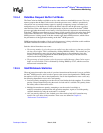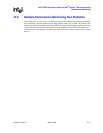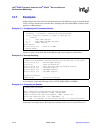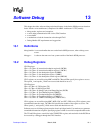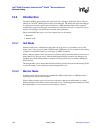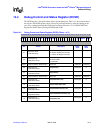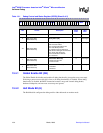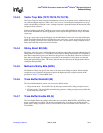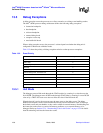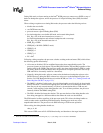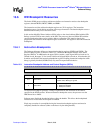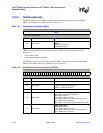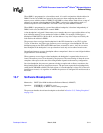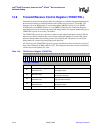
Developer’s Manual March, 2003 13-5
Intel
®
80200 Processor based on Intel
®
XScale
™
Microarchitecture
Software Debug
13.4.3 Vector Trap Bits (TF,TI,TD,TA,TS,TU,TR)
The Vector Trap bits allow instruction breakpoints to be set on exception vectors without using up
any of the breakpoint registers. When a bit is set, it acts as if an instruction breakpoint was set up
on the corresponding exception vector. A debug exception is generated before the instruction in the
exception vector executes.
Software running on the Intel
®
80200 processor must set the Global Enable bit and the debugger
must set the Halt Mode bit and the appropriate vector trap bit through JTAG to set up a non-reset
vector trap.
To set up a reset vector trap, the debugger sets the Halt Mode bit and reset vector trap bit through
JTAG. The Global Enable bit does not effect the reset vector trap. A reset vector trap can be set up
before or during a processor reset. When processor reset is de-asserted, a debug exception occurs
before the instruction in the reset vector executes.
13.4.4 Sticky Abort Bit (SA)
The Sticky Abort bit is only valid in Halt mode. It indicates a data abort occurred within the Special
Debug State (see Section 13.5.1, Halt Mode). Since Special Debug State disables all exceptions, a
data abort exception does not occur. However, the processor sets the Sticky Abort bit to indicate a
data abort was detected. The debugger can use this bit to determine if a data abort was detected
during the Special Debug State. The sticky abort bit must be cleared by the debug handler before
exiting the debug handler.
13.4.5 Method of Entry Bits (MOE)
The Method of Entry bits specify the cause of the most recent debug exception. When multiple
exceptions occur in parallel, the processor places the highest priority exception (based on the
priorities in Table 13-2) in the MOE field.
13.4.6 Trace Buffer Mode Bit (M)
The Trace Buffer Mode bit selects one of two trace buffer modes:
• Wrap-around mode - Trace buffer fills up and wraps around until a debug exception occurs.
• Fill-once mode - The trace buffer automatically generates a debug exception (trace buffer full
break) when it becomes full.
13.4.7 Trace Buffer Enable Bit (E)
The Trace Buffer Enable bit enables and disables the trace buffer. Both DCSR.e and DCSR.ge must
be set to enable the trace buffer. The processor automatically clears this bit to disable the trace
buffer when a debug exception occurs. For more details on the trace buffer refer to Section 13.12,
Trace Buffer.



